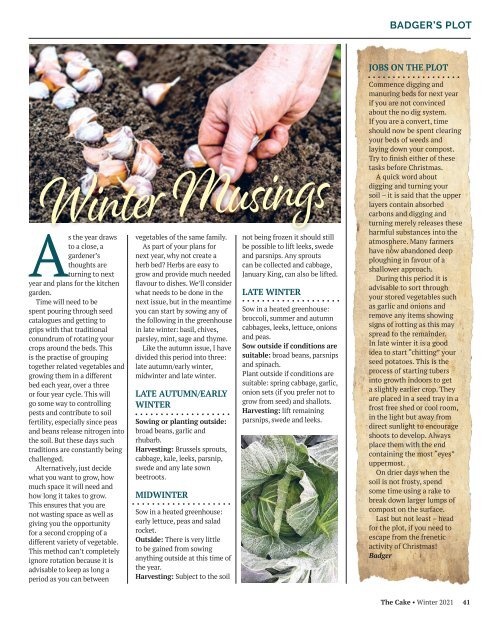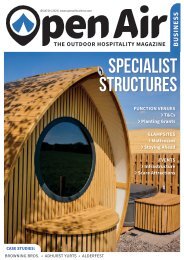The Cake - Winter 2021
A slice of Cranbrook and Sissinghurst life
A slice of Cranbrook and Sissinghurst life
You also want an ePaper? Increase the reach of your titles
YUMPU automatically turns print PDFs into web optimized ePapers that Google loves.
BADGER’S PLOT<br />
JOBS ON THE PLOT<br />
<strong>Winter</strong> Musings<br />
As the year draws<br />
to a close, a<br />
gardeners<br />
thoughts are<br />
turning to next<br />
year and plans for the kitchen<br />
garden.<br />
Time will need to be<br />
spent pouring through seed<br />
catalogues and getting to<br />
grips with that traditional<br />
conundrum of rotating your<br />
crops around the beds. This<br />
is the practise of grouping<br />
together related vegetables and<br />
growing them in a different<br />
bed each year, over a three<br />
or four year cycle. This will<br />
go some way to controlling<br />
pests and contribute to soil<br />
fertility, especially since peas<br />
and beans release nitrogen into<br />
the soil. ut these days such<br />
traditions are constantly being<br />
challenged.<br />
Alternatively, just decide<br />
what you want to grow, how<br />
much space it will need and<br />
how long it takes to grow.<br />
This ensures that you are<br />
not wasting space as well as<br />
giving you the opportunity<br />
for a second cropping of a<br />
different variety of vegetable.<br />
This method cant completely<br />
ignore rotation because it is<br />
advisable to keep as long a<br />
period as you can between<br />
vegetables of the same family.<br />
As part of your plans for<br />
next year, why not create a<br />
herb bed erbs are easy to<br />
grow and provide much needed<br />
flavour to dishes. Well consider<br />
what needs to be done in the<br />
next issue, but in the meantime<br />
you can start by sowing any of<br />
the following in the greenhouse<br />
in late winter basil, chives,<br />
parsley, mint, sage and thyme.<br />
ike the autumn issue, I have<br />
divided this period into three<br />
late autumnearly winter,<br />
midwinter and late winter.<br />
LATE AUTUMN/EARLY<br />
WINTER<br />
Sowing or planting outside:<br />
broad beans, garlic and<br />
rhubarb.<br />
Harvesting: russels sprouts,<br />
cabbage, kale, leeks, parsnip,<br />
swede and any late sown<br />
beetroots.<br />
MIDWINTER<br />
Sow in a heated greenhouse<br />
early lettuce, peas and salad<br />
rocket.<br />
Outside: <strong>The</strong>re is very little<br />
to be gained from sowing<br />
anything outside at this time of<br />
the year.<br />
Harvesting: Subject to the soil<br />
not being frozen it should still<br />
be possible to lift leeks, swede<br />
and parsnips. Any sprouts<br />
can be collected and cabbage,<br />
anuary ing, can also be lifted.<br />
LATE WINTER<br />
Sow in a heated greenhouse<br />
broccoli, summer and autumn<br />
cabbages, leeks, lettuce, onions<br />
and peas.<br />
Sow outside if conditions are<br />
suitable: broad beans, parsnips<br />
and spinach.<br />
lant outside if conditions are<br />
suitable spring cabbage, garlic,<br />
onion sets if you prefer not to<br />
grow from seed and shallots.<br />
Harvesting: lift remaining<br />
parsnips, swede and leeks.<br />
Commence digging and<br />
manuring beds for next year<br />
if you are not convinced<br />
about the no dig system.<br />
If you are a convert, time<br />
should now be spent clearing<br />
your beds of weeds and<br />
laying down your compost.<br />
Try to finish either of these<br />
tasks before Christmas.<br />
A quick word about<br />
digging and turning your<br />
soil it is said that the upper<br />
layers contain absorbed<br />
carbons and digging and<br />
turning merely releases these<br />
harmful substances into the<br />
atmosphere. any farmers<br />
have now abandoned deep<br />
ploughing in favour of a<br />
shallower approach.<br />
uring this period it is<br />
advisable to sort through<br />
your stored vegetables such<br />
as garlic and onions and<br />
remove any items showing<br />
signs of rotting as this may<br />
spread to the remainder.<br />
In late winter it is a good<br />
idea to start “chitting your<br />
seed potatoes. This is the<br />
process of starting tubers<br />
into growth indoors to get<br />
a slightly earlier crop. <strong>The</strong>y<br />
are placed in a seed tray in a<br />
frost free shed or cool room,<br />
in the light but away from<br />
direct sunlight to encourage<br />
shoots to develop. Always<br />
place them with the end<br />
containing the most “eyes<br />
uppermost.<br />
n drier days when the<br />
soil is not frosty, spend<br />
some time using a rake to<br />
break down larger lumps of<br />
compost on the surface.<br />
ast but not least head<br />
for the plot, if you need to<br />
escape from the frenetic<br />
activity of Christmas<br />
Badger<br />
<strong>The</strong> <strong>Cake</strong> <strong>Winter</strong> 41


















